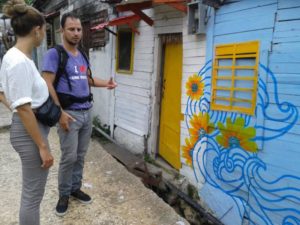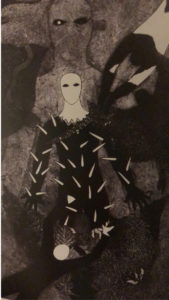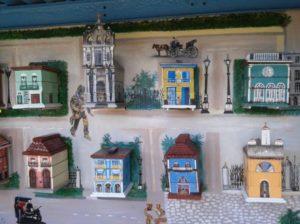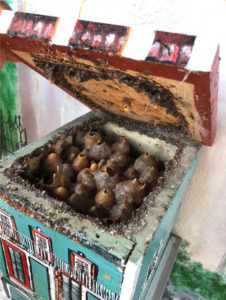Days go by quickly, as it always happens when you are enjoying yourself. This morning Claudia and I went to visit Havana University and, while she was showing me the different departments telling me about their history, we came across quite an incredible situation. On the floor of the wide porch at the building’s main entrance there was a huge mosaic which I’d like to show you for various reasons (please see cover image).
After a lunch of lobster, fresh fruit and vegetables, we head towards Los Positos, one of Havana’s 35 poorest neighbourhoods (that’s actually how strong the contradiction is in this city as well as in the whole of Cuba). Most of the houses in the neighbourhood are metal or wood huts, the roads are not paved and only a few huts have running water, but they all have a TV set. Claudia and I meet Michael Sànchez Torres, an archaeology professor collaborating in the Third Paradise activities with the project “Akòkan”. Los Positos houses a big Avaquà community, a secret society of males of Afro-Cuban origin pervaded by a Christian and Voodoo syncretism.
The sect is considered by many a Cuban version of the Masonry, practising rites of initiation, rebirth, purification, death, execution and sacrifice. Michael lives in Los Positos with his wife and two daughters, he knows and cooperates with this community. Through their collaboration with the Third Paradise project and the help of local youths and adults, they have built a small bar along the river crossing the neighbourhood, a clinic complete of medical equipment, and a study room furnished with table, chairs, bookshelves with books, pencils, felt pens, etc. They have also bought a big plot of land in which they will plant medicinal plants, beans and vegetables grown and consumed by the community. Michael and his wife also have a sort of restaurant, which is actually a house, their house.

They offer pre-booked gastronomical experiences, it’s a set menu of traditional Cuban dishes, all the products are locally sourced, fruit and vegetables are organic and the meat comes from animals farmed in the area in open air spaces. Oddara, this is the name of the home-restaurant, is one of the main sources of income to support the Akòkan project.
Whilst eating a flan, a Cuban dessert similar to panna cotta, Claudia and Michael tell me about a contemporary Cuban artist, Belkis Ayòn. Through the study of the Abakuà secret culture, the artist produced a series of black and white calligraphies with almost pop and very macabre features (see image on the left). These works allow us to observe the ingredients and the ethical values of this patriarchal culture, but also the nature of myths, legends and taboos. Belkis was found dead on 11 September 1999: she was in her bathtub, with a bullet in her head and no gun in sight, she was 23.
The days keep going by. Each morning I have breakfast with eggs and fruit, juice and coffee, while Caruca, my adoptive “abuelita”, is busy in the kitchen with beans, strange edible roots, chickens and heaps of rice. Marianela moves from one room to the other trailing her billowing long colourful dresses behind her. Almost every morning Claudia comes to pick me up at around 10, we take an almendròn and we head to an artistic centre, a restaurant, an office or a school, today it’s the Tungasuk farm.
Annabelle Cantarero and Alfredo Wilson are from Nicaragua and Peru respectively, they have travelled around Africa and Congo together and lived in France, where Annabelle studied to be a chef, before moving to Cuba. Their finca is about 50 minutes from Havana, immersed in luxuriant, tropical, invasive greenery. They grow all sorts here, everything is rigorously organic and sustainable: from beans to carrots, mangoes, potatoes, bananas, rosemary, tomatoes and peppers. I am sent to gather chives and rocket, Claudia cuts tomatoes, Alfredo peppers and coriander; we are about to have lunch with pan-fried rice and vegetables, and ginger lemonade. After lunch, faithfully accompanied by David and his red almendròn, we go to the agro-ecologic farm “La Burgambilia”.
Alexander, the manager, welcomes us and, shortly afterwards, shows us a few tiny houses hanging from the wall: each house represents a historical monument of cultural value for Cuba. The little houses are hives of honey bees of a particular species without stinger which feeds on the pollen of medicinal plants, which makes their honey incredibly scented and curative. Alexander and his colleagues have created a three-tier structure for the beehives. Eggs are laid on the first level, nectar on the second and honey on the third.
This anthropomorphic structure has been well received by the bees since the first prototype of little house was created, allowing bee keepers to collect the honey without disrupting the whole beehive. If this is not a perfect example of a balance between human intelligence and natural resources (a Third Paradise!), I wouldn’t know what else could be.


Throughout my stay in Havana, I got to know two very different but at the same time very similar cooks. Raulito Bazuk, manager and chef of the restaurant “Grados”, wants to transform his restaurant into an informal contemporary art gallery, in which the culinary and artistic experiences meet; a place where artists and non-artists eat together and share ideas.
Each week Raulito travels from farm to farm to buy ethically grown products, thus supporting the local economy. Claudia, Marianela, Sunlay (artist and professor of experimental composition of classical music for children) and I went to Raulito’s restaurant for lunch. We took part in the workshop “Truco o Trato?” (trick or treat?), in which a customer is invited to go to the kitchen while the food is cooked and to move, add and change the various dishes being prepared, not knowing which one will be theirs, this way breaking down the barriers dividing and defining the roles of creator and consumer.
The other extraordinary cook I met is Yunalvis Hernàndez, manager and chef of the restaurant “Camino del Sol, NaturalMente Vegetariano”. This visionary and energetic woman is collaborating with Claudia, and therefore with the Third Paradise project, in organizing the “Festival de la Tierra”. It is a fair of cooperatives, private individuals, artists and farmers working towards an eco-coexistence with nature and its products through creativity and human technology.
Each single person met in the course of my stay in Cuba inspired, helped and stimulated me to do my best, with simplicity and spontaneity. Cuban society benefits from a wealth difficult to understand for the rest of the world, a wealth composed of hundreds of years of cultural blending, skills and recycling techniques born from, if not imposed by, an extreme poverty, and a sense of solidarity and of belonging to a community we have a lot to learn from.
Thank you Cuba! Thank you Cuban people! Thank you Third Paradise!

